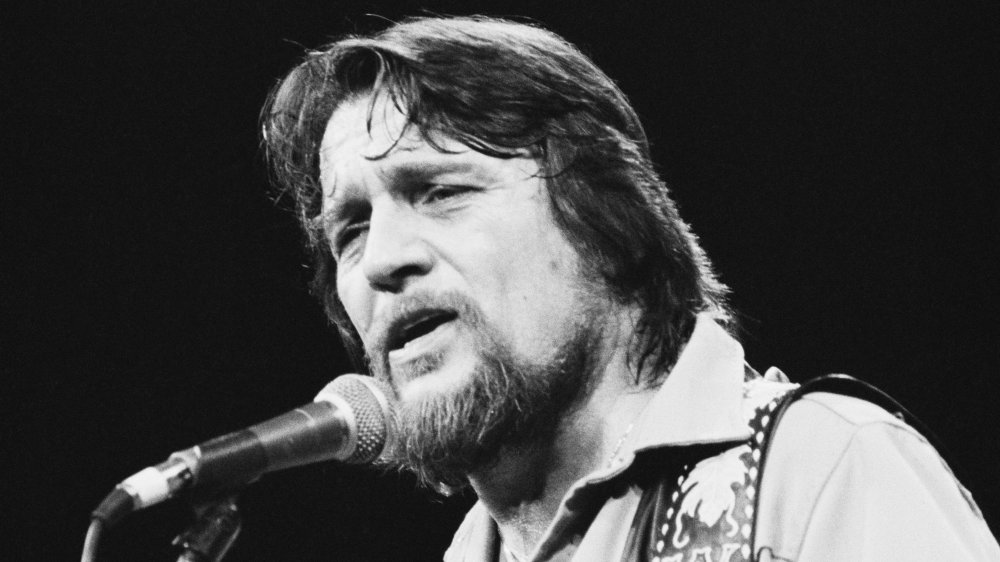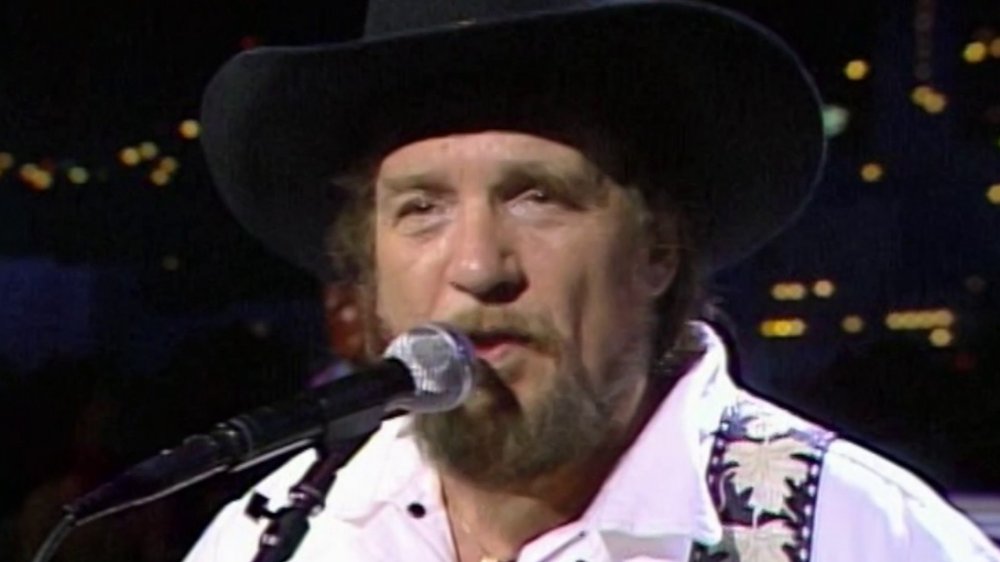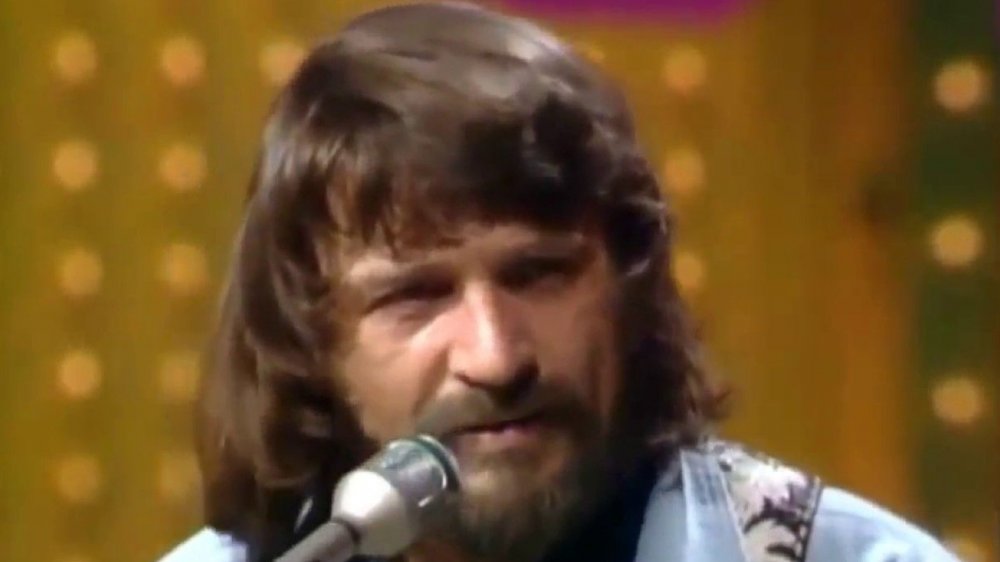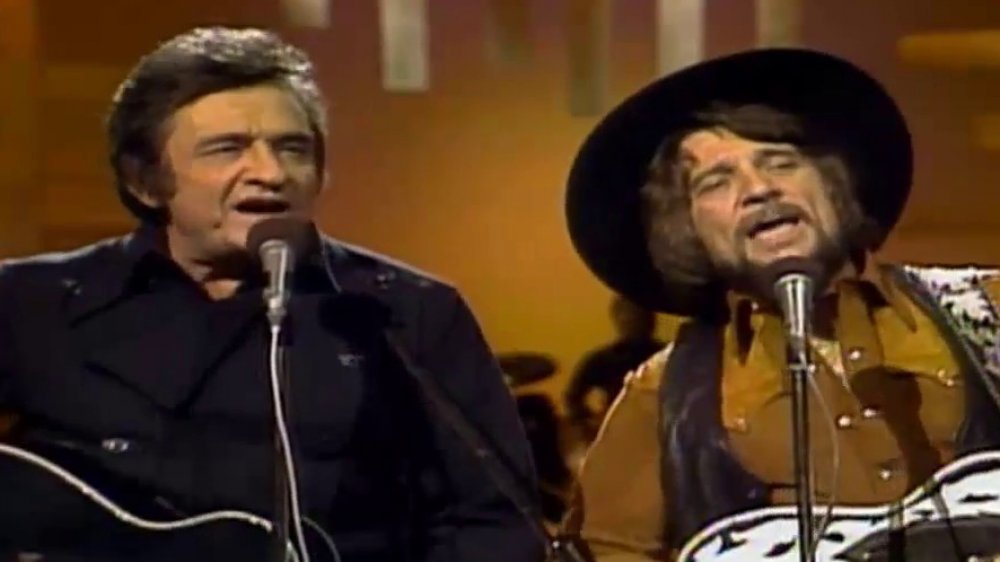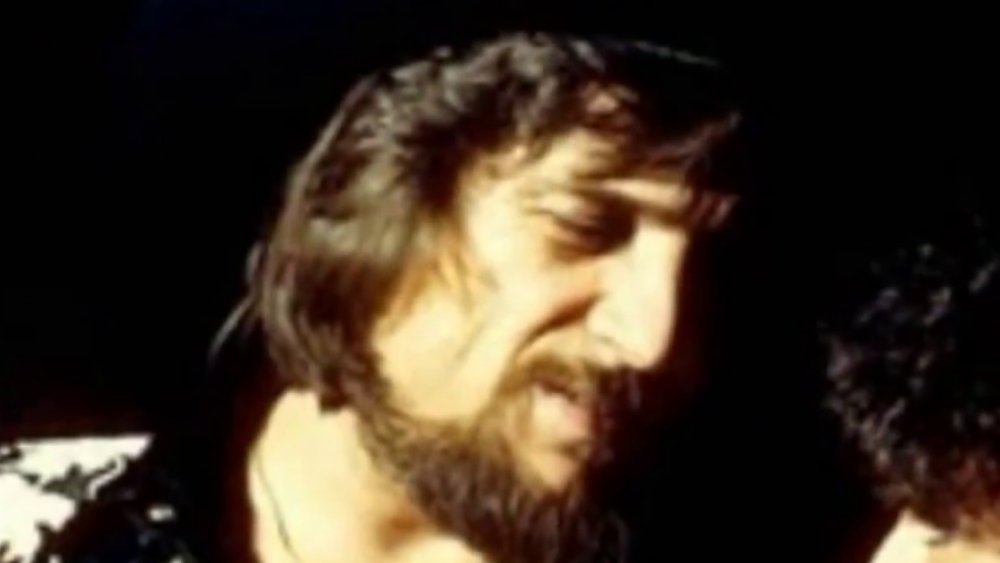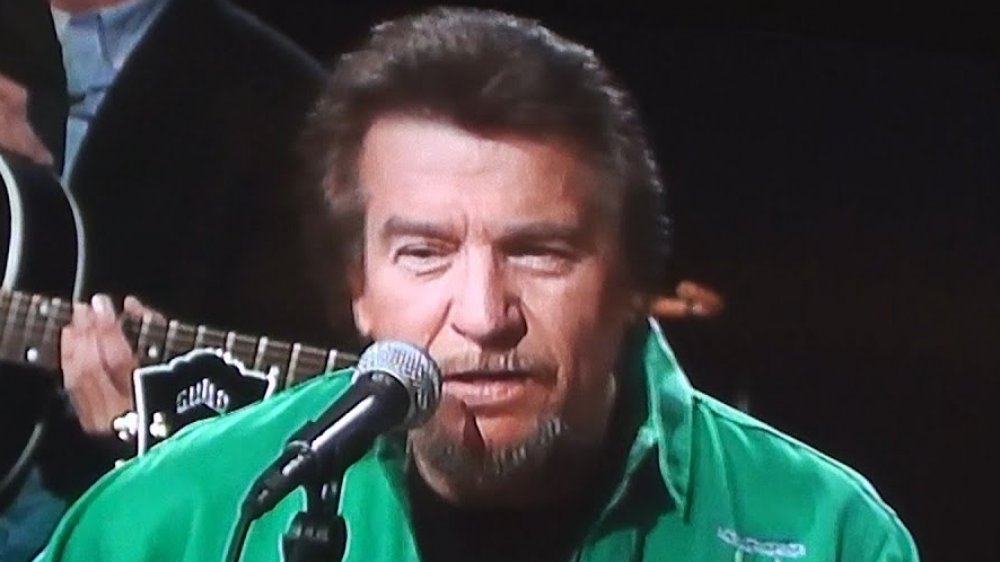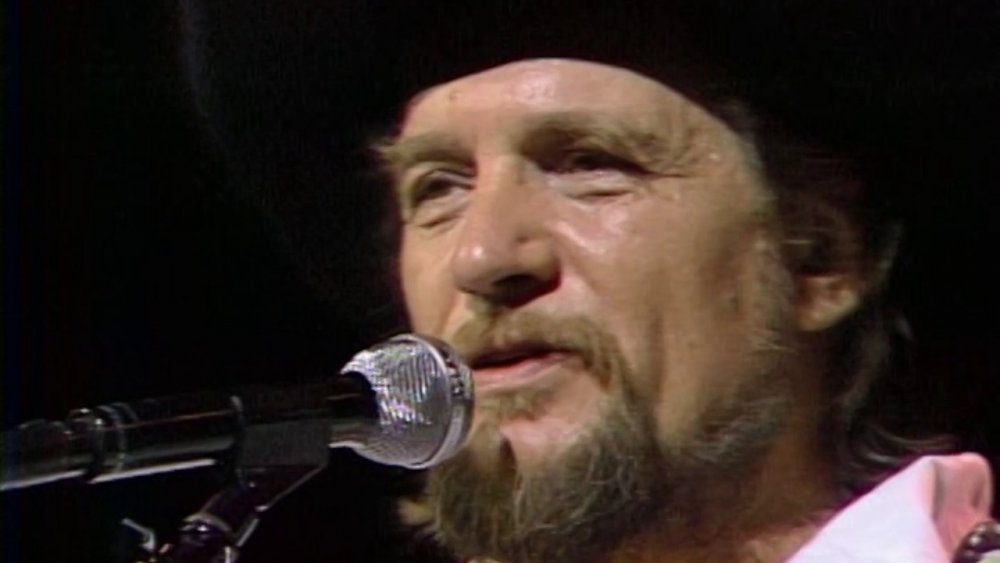The Tragic Real-Life Story Of Waylon Jennings
There's but a handful of country music superstars, let alone American singers of any stripe, known by just a single name, one that conjures up romantic imagery of their songs. We're talking about Willie, Johnny, Merle, and perhaps most of all, Waylon, as in Waylon Jennings, a towering figure in country music.
The Texas-born singer, songwriter, and guitarist was the face and voice of his genre in the '70s, leading the "outlaw country" movement and injecting an intensity and grit back into the form that had fallen away during that decade of pop-leaning, overproduced tunes. Jennings made what many would call "real country" — songs of heartbreak, hard luck and hard choices, like "I'm a Ramblin' Man," "I've Always Been Crazy," and "Sweet Dream Woman." (He was also heard in millions of homes every week as the voice of "The Balladeer" on The Dukes of Hazzard.)
As it turns out, Jennings knew that of which he sung, living a tough life marked with pain, struggle, and loss. Here's a look at the tragic, ramblin' life of Waylon Jennings.
Waylon Jennings could've died in an infamous plane crash
Waylon Jennings was just getting his career started in 1959 with some recording sessions produced by Buddy Holly, already a star in the burgeoning genre of rock 'n' roll with smash hits like "That'll Be the Day," "Peggy Sue," and "Maybe Baby." Holly even offered Jennings a chance to play bass in his band on the Winter Dance Party Tour, a package show that also included J.P. Richardson, aka the Big Bopper, performer of the hit "Chantilly Lace," and Ritchie Valens, who reworked the folk song "La Bamba" into a rock classic.
The acts' tour buses kept breaking down, so after a gig in Clear Lake, Iowa, on February 2, Holly chartered a plane to get himself and his band to the next show in Fargo, North Dakota, rather than take his chances with another road coach. As it was the winter, the flu was going around, and both Richardson and Valens were quite ill. Richardson, who was originally going to take a bus, asked Jennings if he could have his spot on the small plane. Jennings was kind enough to do so, and Holly joked to him that he hoped their bus broke down, to which Jennings replied, "I hope your ol' plane crashes." Horrifyingly, that's exactly what happened. Everyone on board — Richardson, Holly, Valens, and pilot Roger Peterson — were thrown from the plane when it crashed shortly after liftoff, and none survived.
He was married four times
Waylon Jennings' love life is synonymous with his long relationship with Jessi Colter (pictured), whom he married in 1969. She's the mother of his most famous kid, Waylon Albright Jennings, aka indie country star Shooter Jennings. While it was happily ever after for Jennings, things weren't so smooth in his early years. The country legend was married — and divorced — on three other occasions. The first wedding was to Maxine Lawrence when Jennings was only 17. They had four kids in their six years together before Jennings moved on in 1962 to Lynne Jones, with whom he adopted a daughter and divorced after five years. He was then briefly married to Barbara Road before he fell in love with Colter. He helped her re-launch her recording career (a couple of '60s singles that didn't go anywhere), and he credits her with turning his life around.
"When I met Jessi, I was pretty well at my lowest point," Jennings later told Rolling Stone. "I weighed 138 pounds, and I was bent on self-destruction. Wallerin' in self-pity was the biggest part of it, stayin' depressed all the time and stoned. Jess was the best thing that ever happened to me." Still, the marriage was rocky on occasion. Jennings told People that his cocaine addiction put his wife "through hell," and they once separated for a short while. But to paraphrase the couple's duet, storms never last, and they stayed married until Jennings' death.
Waylon Jennings contracted hepatitis
Waylon Jennings certainly did his fair share of hard living, but in 1972, the 35-year-old singer got extremely sick and could've died after he ingested the otherwise innocuous substances of pie and milk in a diner on the Colorado border. As he wrote in Waylon: An Autobiography, Jennings remembered right after his snack that he'd been warned before heading out to the area on a tour to not eat anything locally made due to an outbreak of hepatitis, an inflammatory disease that powerfully attacks the liver.
In the hours after he ate the tainted pie (or tainted milk), Jennings said he felt "sick and battered," but he moved along to his next gig. Immediately after performing, he was uncharacteristically exhausted, with back and kidney pain. Jennings' wife, Jessi Colter, said he looked yellow — a telltale symptom of hepatitis — but he figured it was just the reflective glow of his gold-colored shirt. And then he passed out, waking up later to a doctor telling him he had hepatitis. At first, he denied treatment, but when his condition worsened, he finally agreed to his wife's suggestion that he seek professional treatment in a hospital.
He had a major cocaine addiction
In the 1970s and 1980s, according to People, Waylon Jennings was gripped by a powerful addiction to cocaine. And according to Taste of Country, not even an August 1977 bust by police at a Nashville recording studio — where he had so much cocaine on his person that he was charged with intent to distribute — could get him to quit. The effects of the drug seemingly hadn't affected his work much ... until a 1984 show in Portland, Oregon, when he mumbled his way through just a few songs and stumbled off the stage to a chorus of boos.
Around that time, he'd quit eating, and his wife, Jessi Colter, forced him to drink protein-fortified milkshakes. He felt depressed and desperate about his situation but unable to quit until fellow country music icon Johnny Cash recommended he try the Betty Ford Center, which helped him kick his own addiction to painkillers. That was the motivation Jennings needed but not the route. Having already failed to quit drugs with a stint in rehab, he instead went "cold turkey," isolating himself and his family in Arizona. But first, as Colter told Garden & Gun, he flushed $20,000 worth of cocaine down the toilet, promising to never do the drug again. And he was true to his word.
Waylon Jennings filed for bankruptcy
As a major singer-songwriter, recording artist, and concert draw throughout much of the latter half of the 20th century, Waylon Jennings made a lot of money. Unfortunately, he also blew through that money while trying to make music and bringing it to the people.
According to his memoir, Waylon: An Autobiography, Jennings went broke no less than three times. At one point, his home and other real estate holdings had been seized, his bank accounts had been closed, and his advances were spent well before album releases. He attributed part of that to paying a huge staff that included "a road manager, a band manager, a publicist, a secretary, a booking agent, a receptionist, gofers, and personal assistants all around." While on the road, Jennings also employed multiple crews, production managers, roadies, plus a convoy of trucks and buses to transport all the equipment and people.
In 1981, Jennings filed for bankruptcy, citing $2.5 million in debt. Of course, when it came to his financial matters, there was also the issue of his drug habit. Not only is cocaine addictive and unhealthy, it's expensive. At his peak of consumption, Jennings was spending $1,500 a day on the stuff.
He had heart problems
Cocaine is very bad for the heart. And although Waylon Jennings stopped using the drug in 1984, he still endured heart troubles many years later. In October 1988, doctors performed a balloon angioplasty to clear a blocked artery. Just two months later, while on his tour bus and headed to a gig in Tennessee, a 51-year-old Jennings started to suffer from chest pains so intense that his driver immediately re-routed to Baptist Hospital in Nashville. Tests revealed partial blockage in three of Jennings' arteries, necessitating immediate triple-bypass surgery. Fortunately, at no point did he suffer a heart attack, and he made a full recovery. Under doctors' orders of rest and relaxation, Jennings canceled two months' worth of concerts, and he also had to adopt healthier habits, and fast.
"I had to change the way I eat," Jennings told UPI. He also had to give up smoking, a prodigious habit he picked up when he was around ten years old. "Smoking is what caused my problem. I smoked for 41 years, and I was smoking five and six packs a day in the last few years."
Waylon Jennings suffered from complications of diabetes
Cocaine discourages appetite, and that happened for Waylon Jennings, who during the height of his addiction subsisted on milkshakes force-fed to him by wife Jessi Colter. After he quit taking the drug in the mid-1980s, the desire for food returned, and Jennings put on a few pounds. "I hated the way I looked, because once I started gaining weight, I couldn't stop," he wrote in Waylon: An Autobiography. After less than a decade of living a drug-free life, albeit one with some extra weight on his frame, Jennings was diagnosed with adult-onset, or type II diabetes. It often develops in older, overweight adults, and it's characterized by the body's inability to properly process food or regulate blood glucose levels, which can lead to severe complications, including kidney problems, vision loss, and poor circulation.
That last problem happened to Jennings. Blood flow in the arteries in his legs was so impeded that he was diagnosed with peripheral vascular disease in both limbs. In April 2000, he underwent surgery in hopes of relieving some of the tremendous pain he was in. Unfortunately, Jennings' health problems continued. In 2001, he got an infection in his foot, and his body, ravaged by diabetes, couldn't fight it off. Doctors had to amputate it. About two months later, the country legend passed away at age 62, owing to diabetes-related issues.
